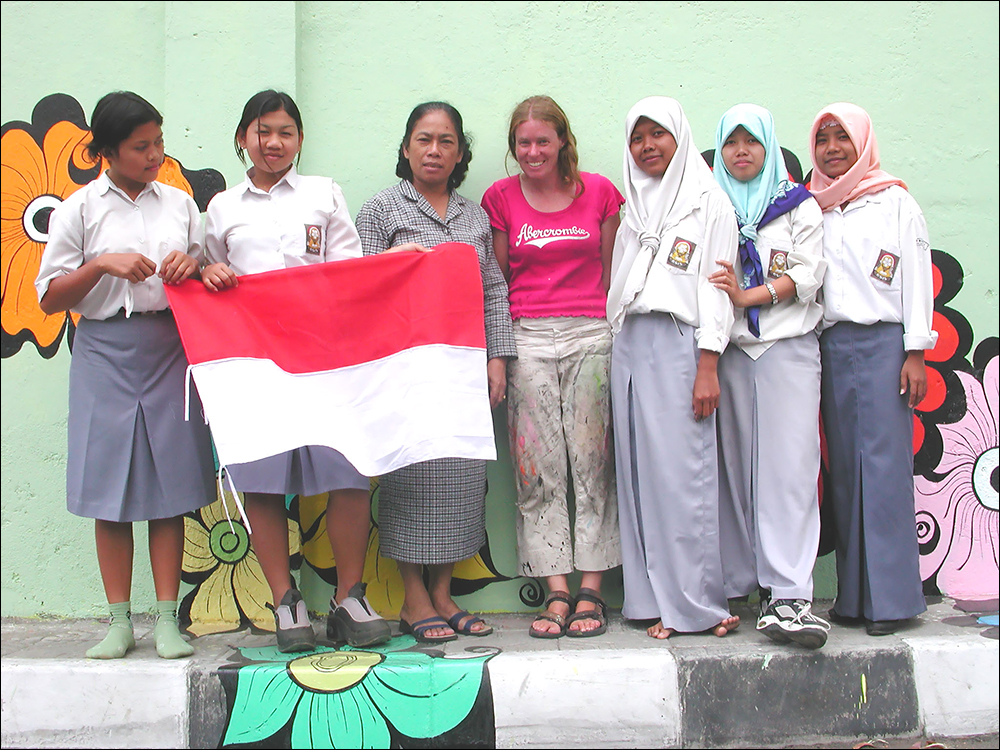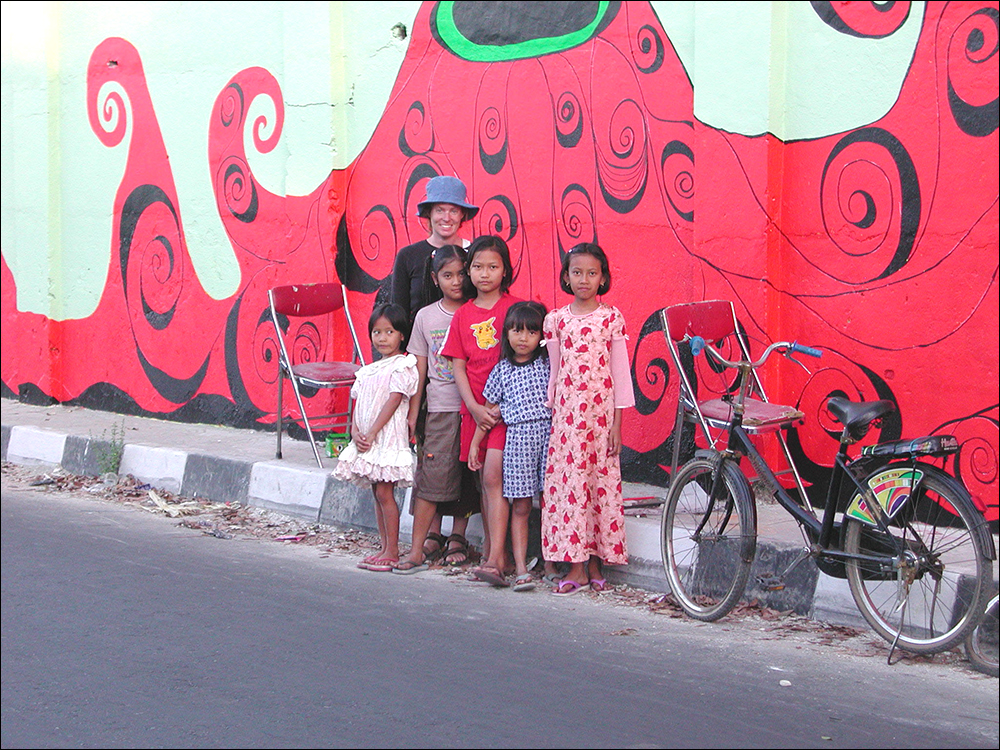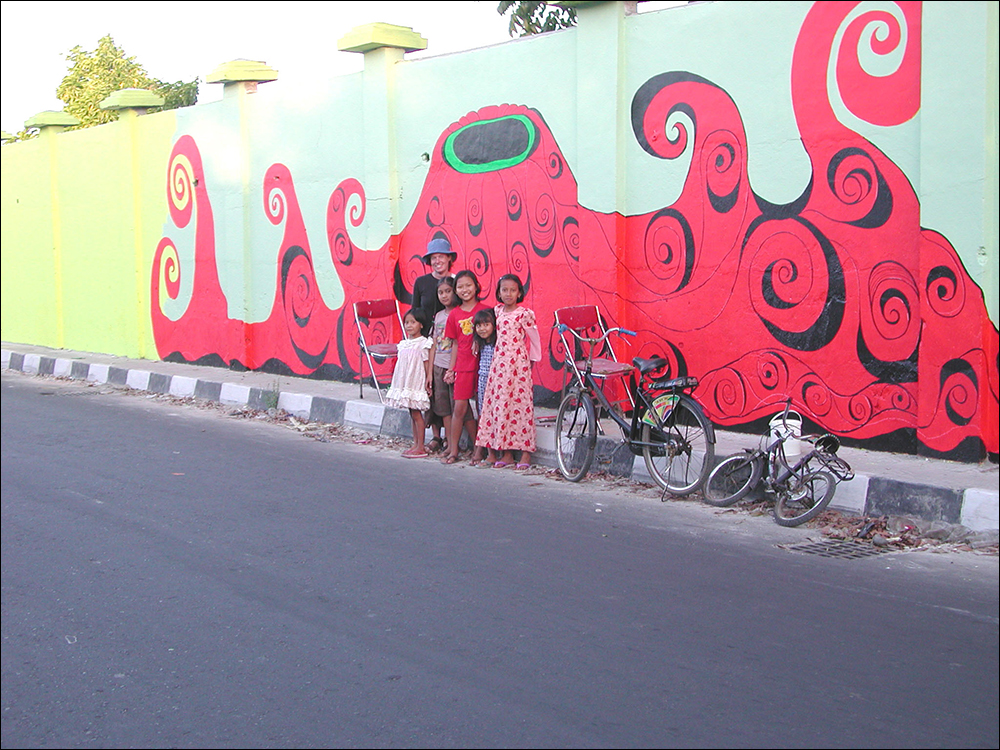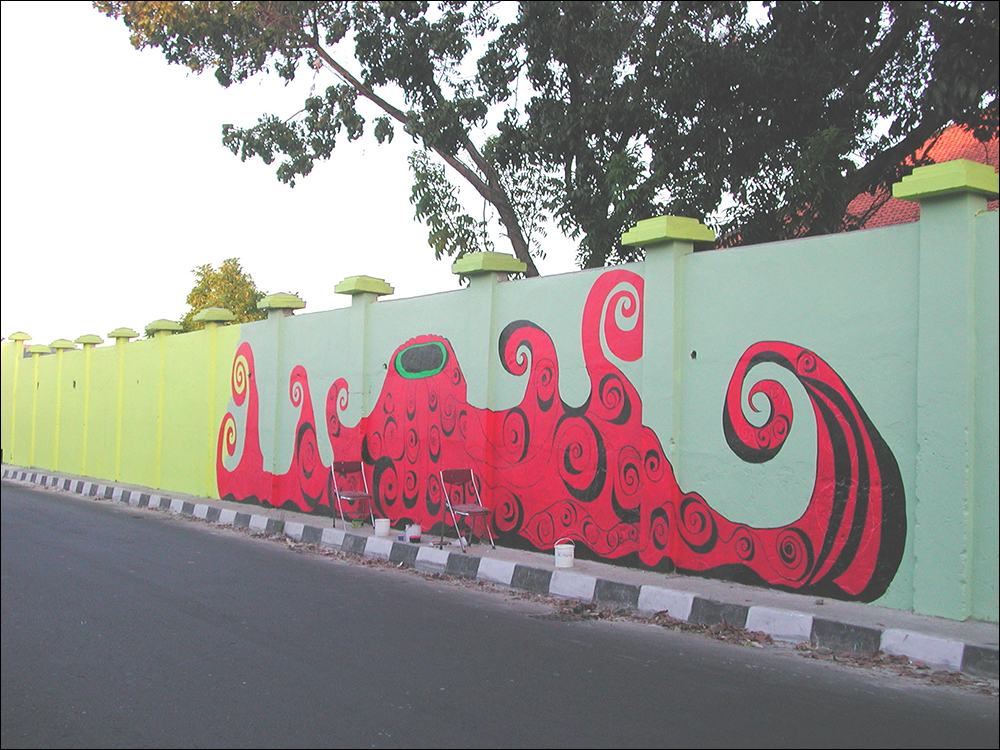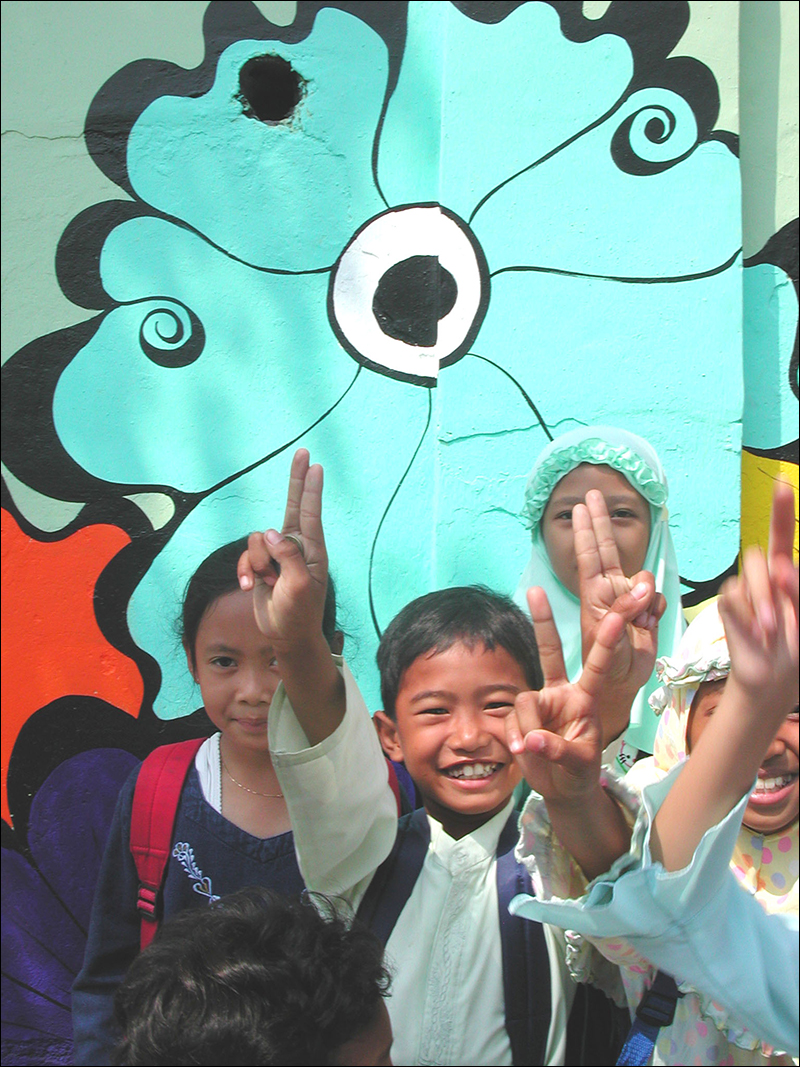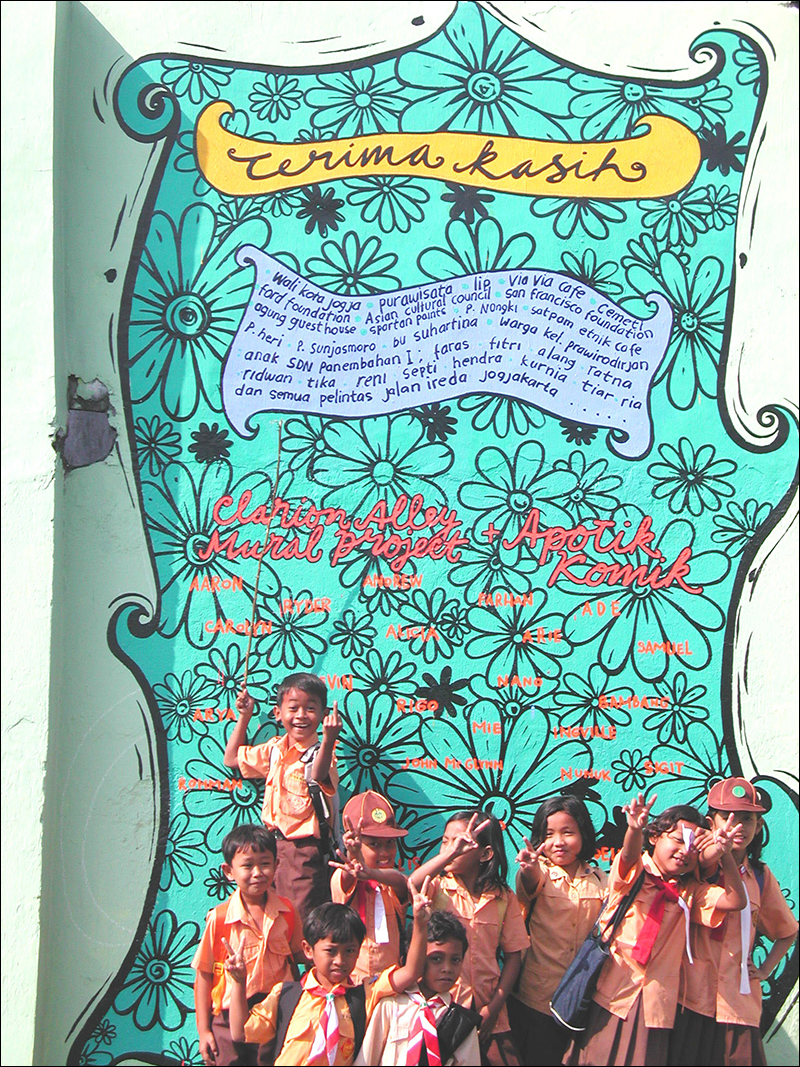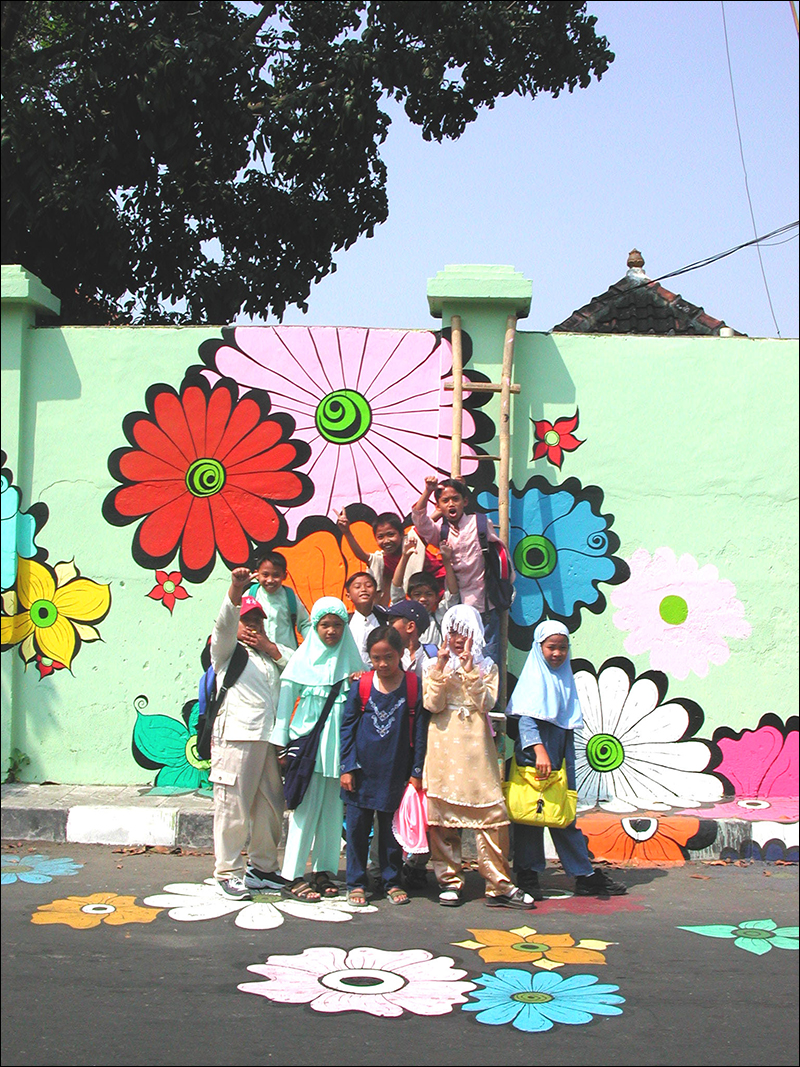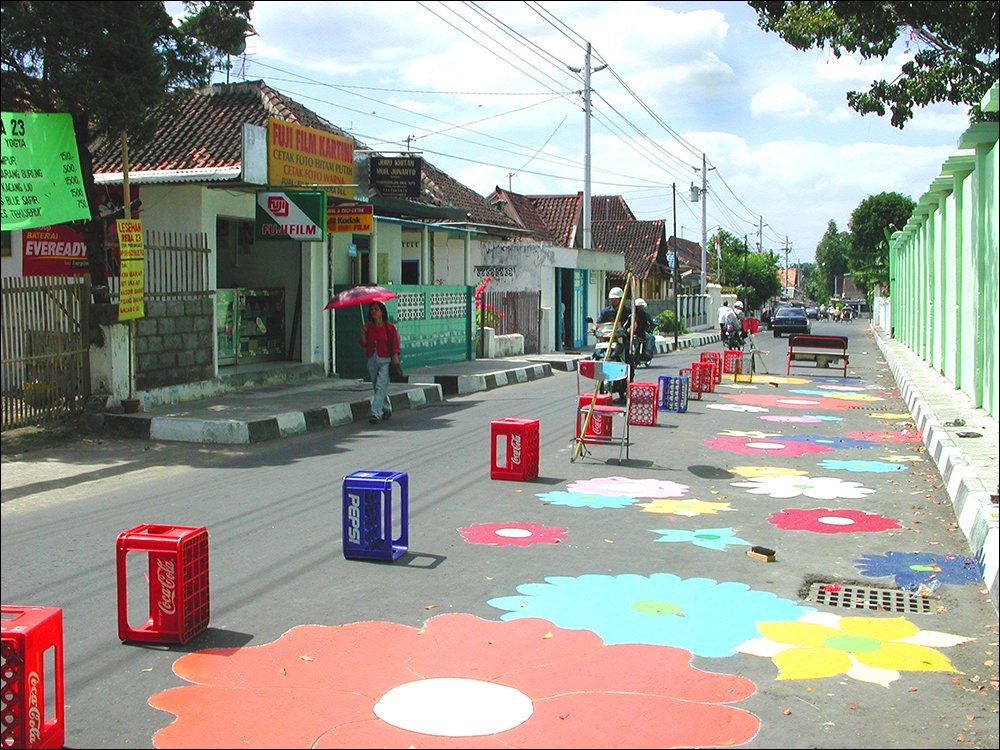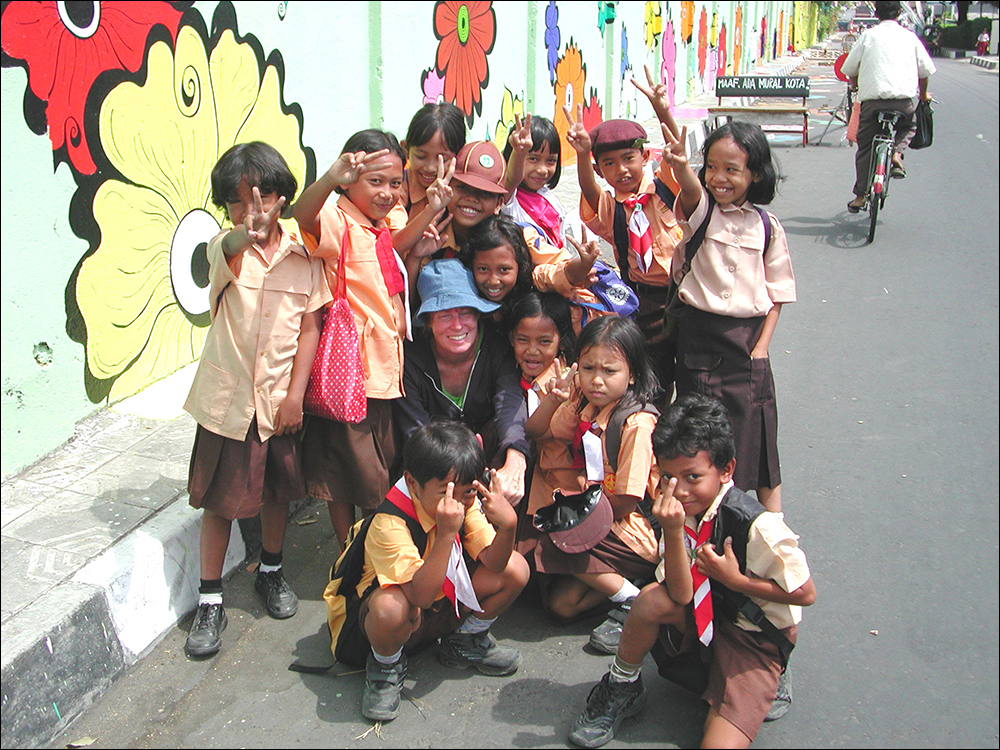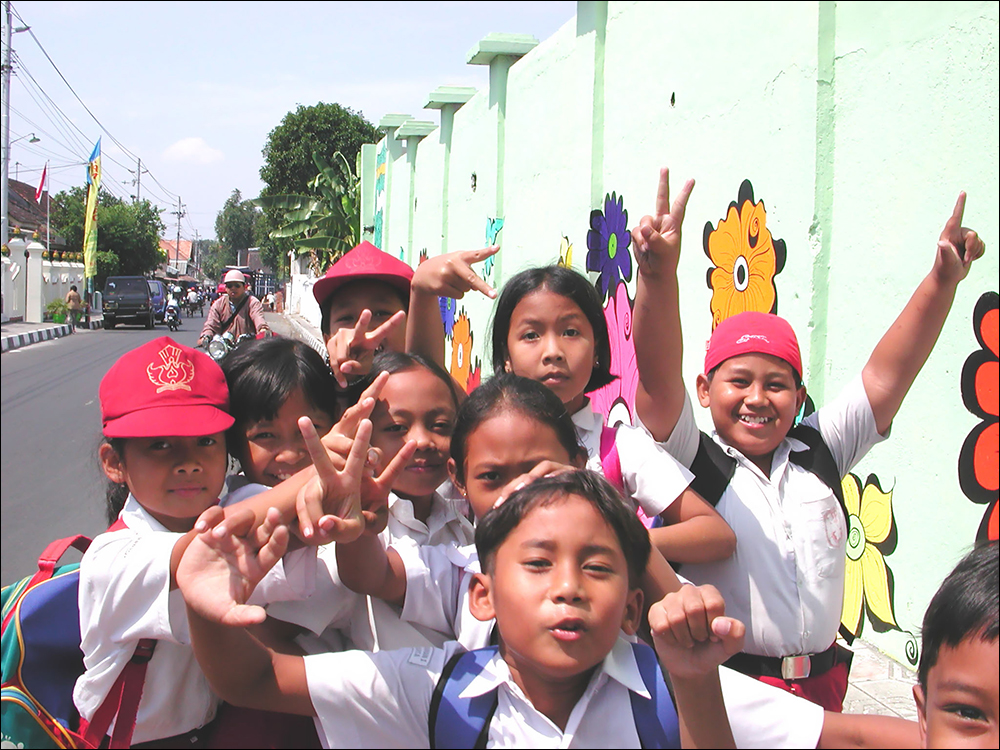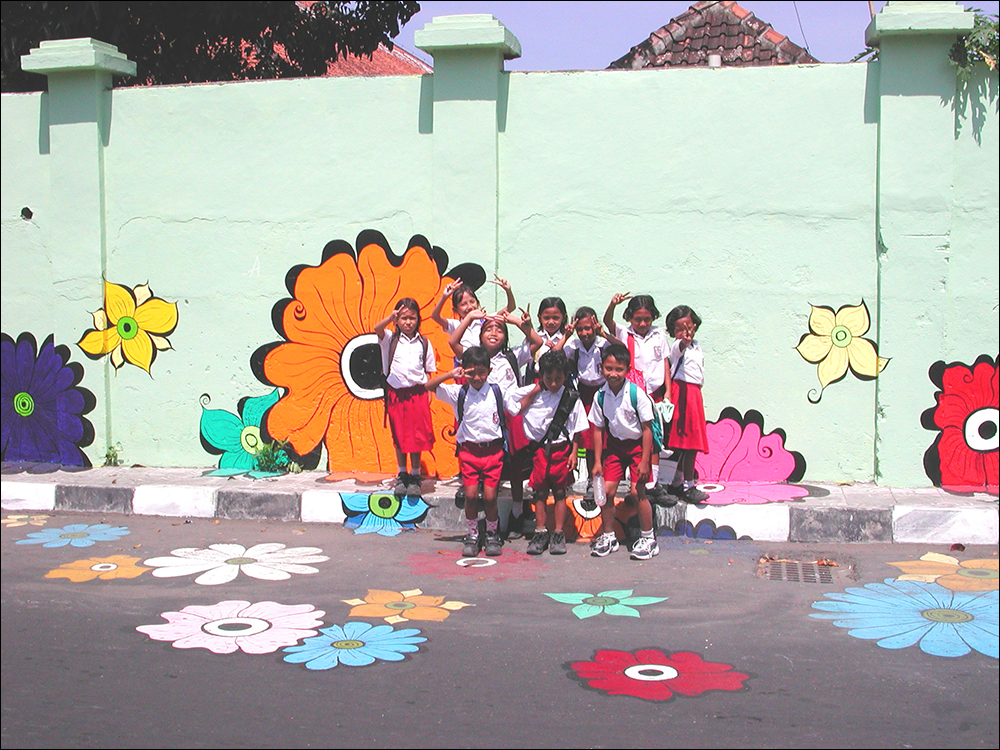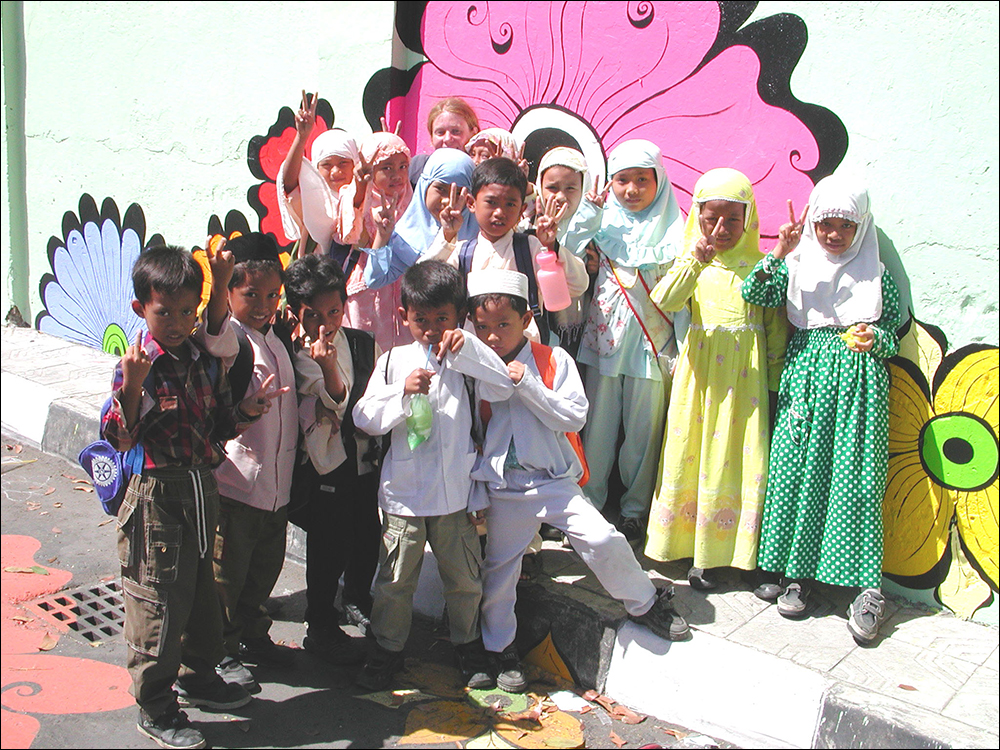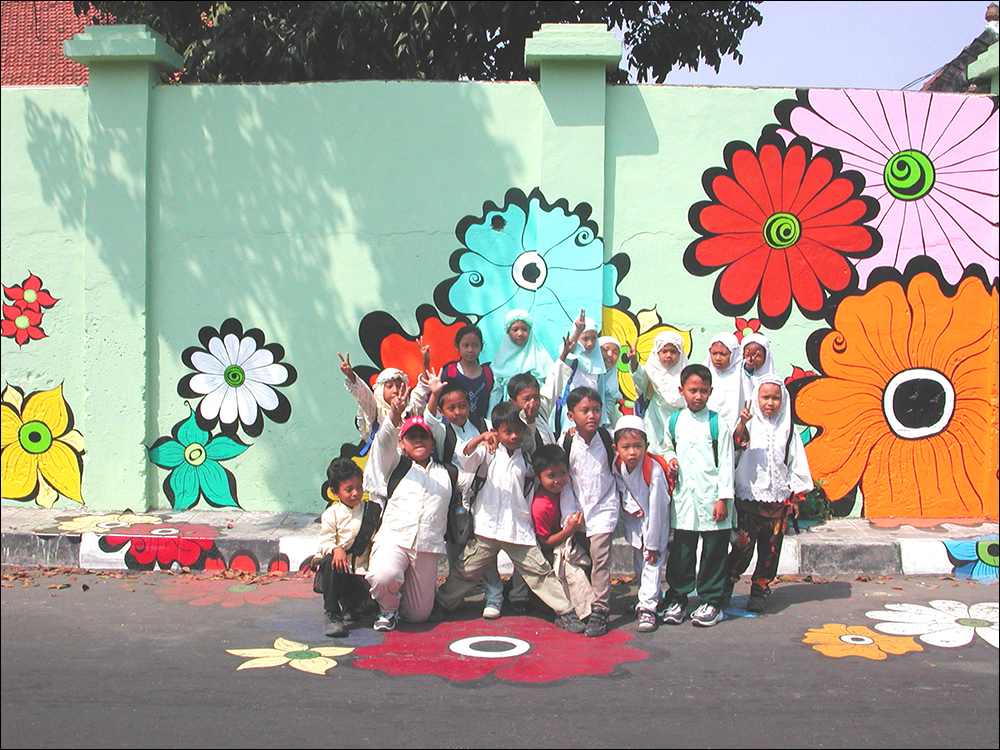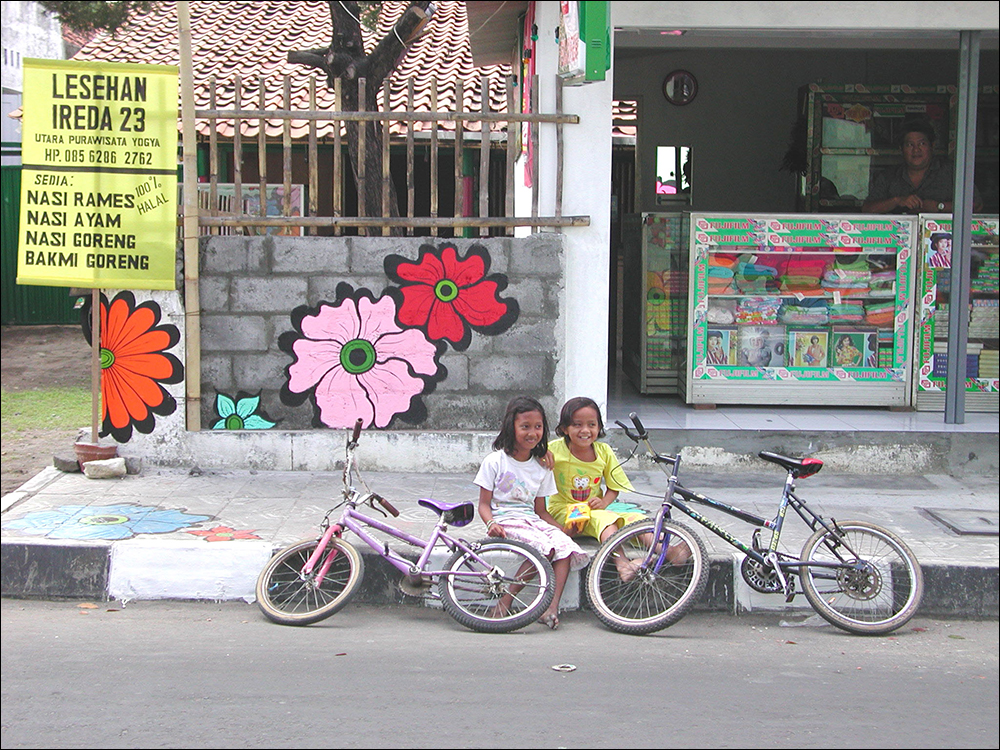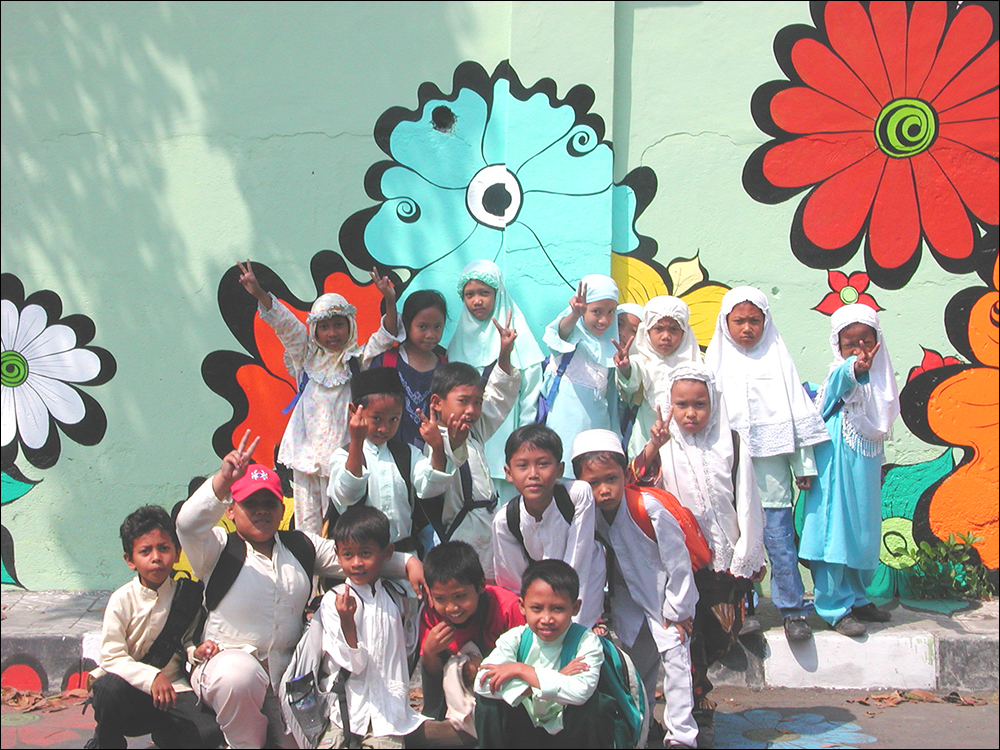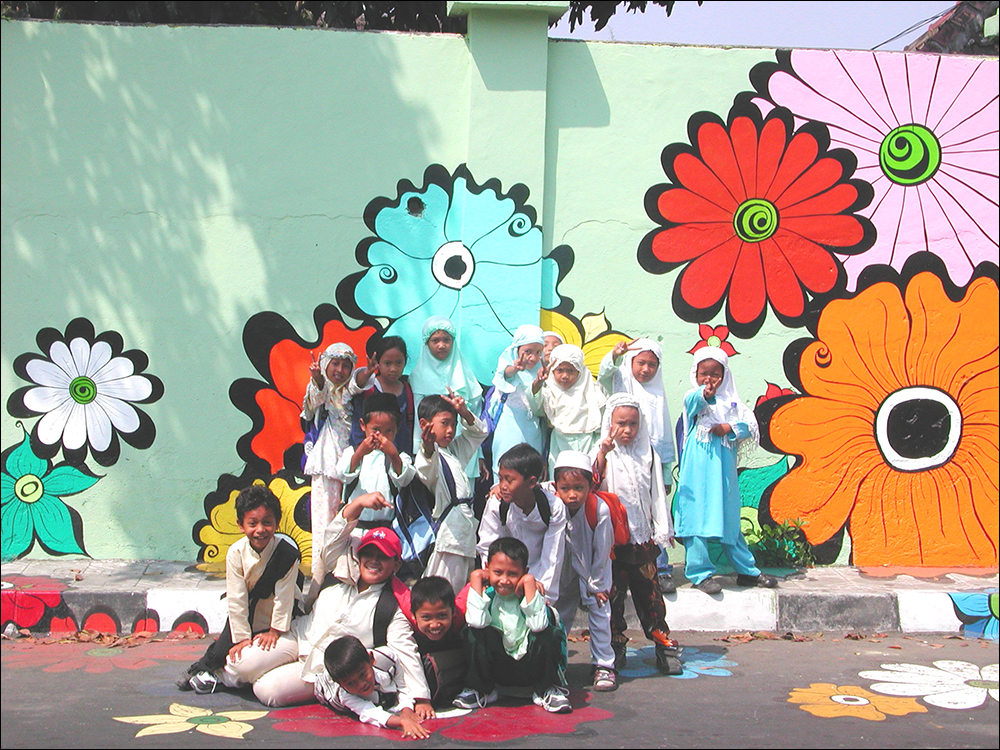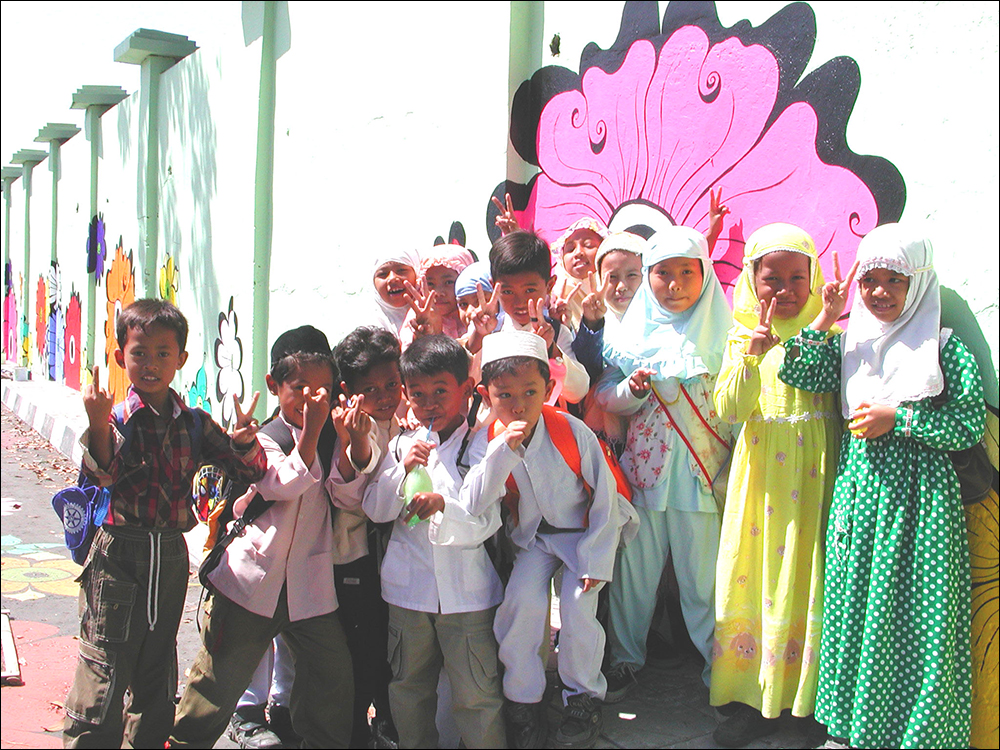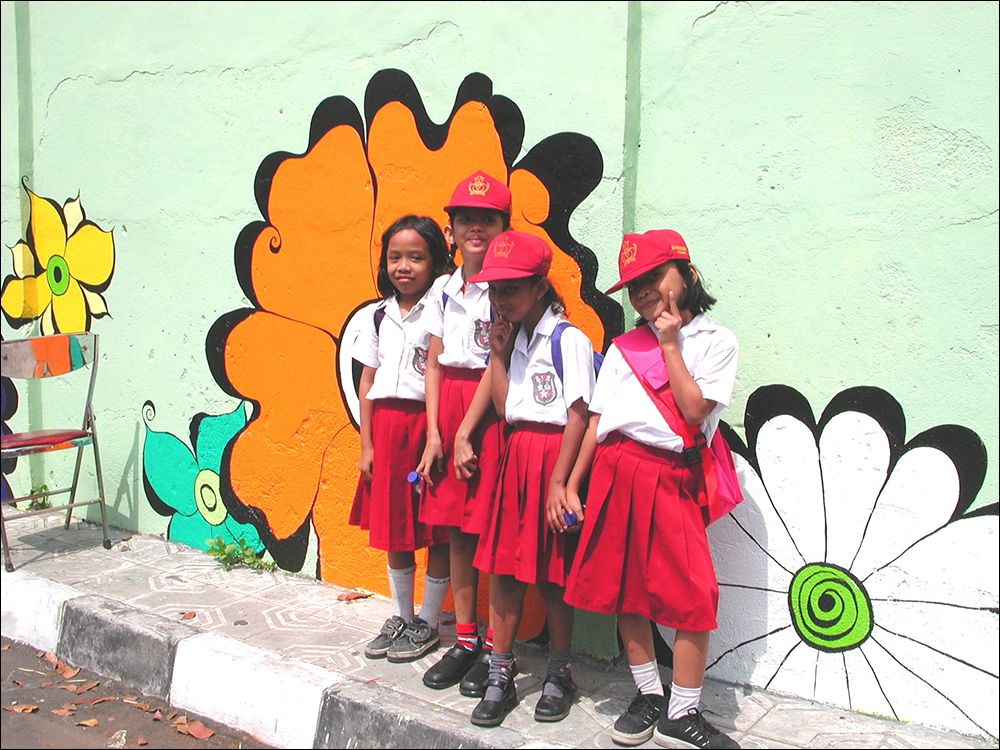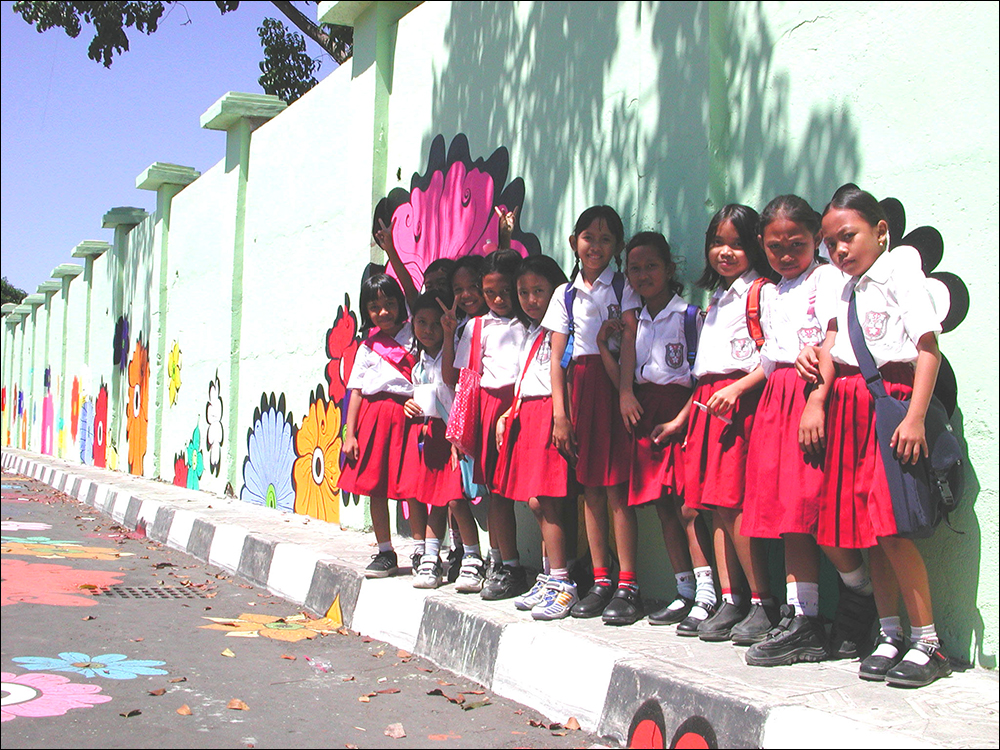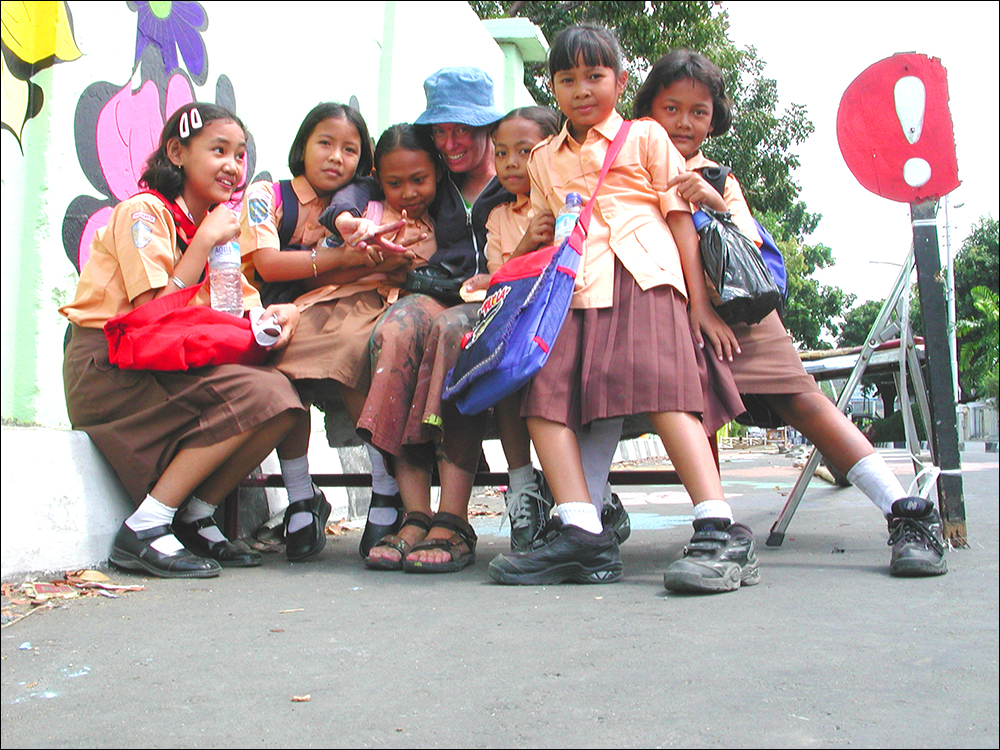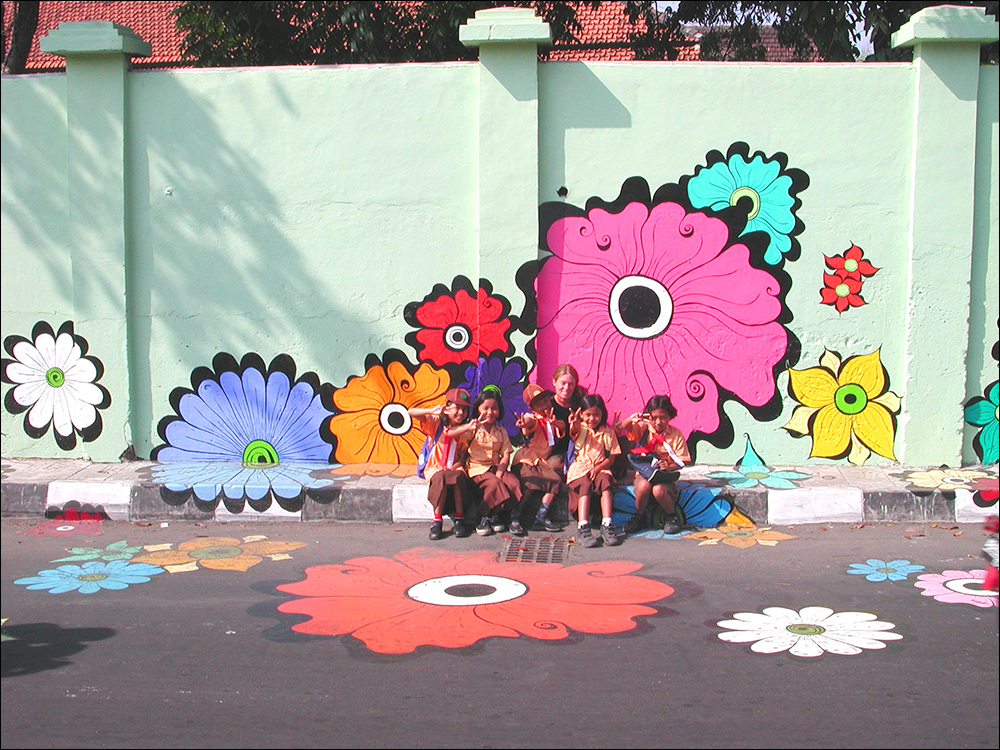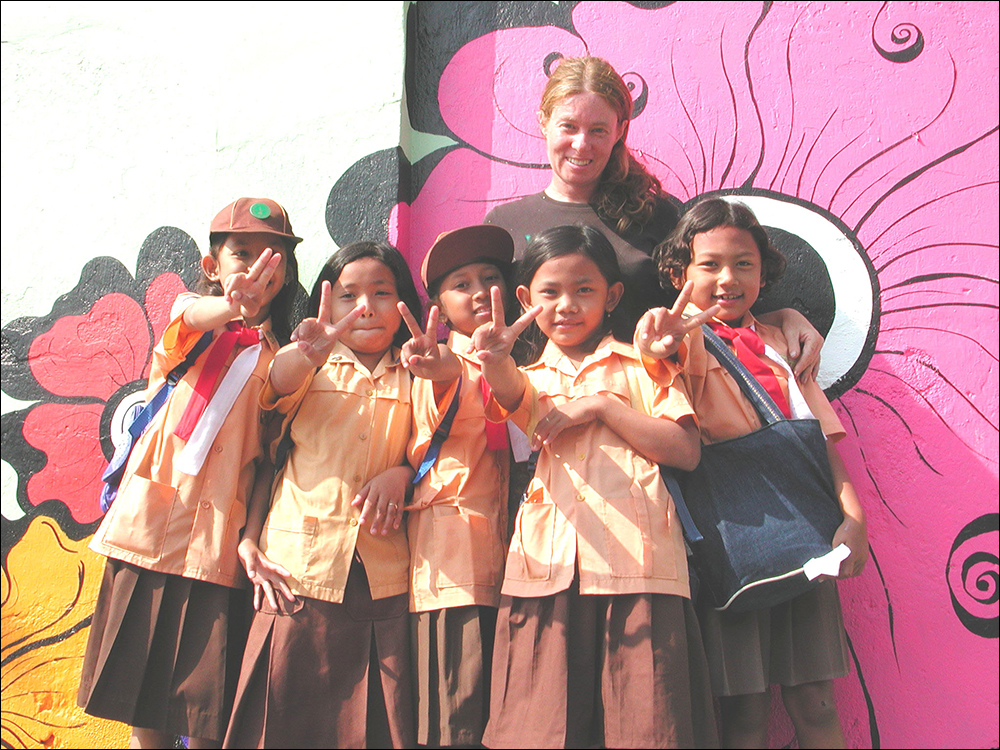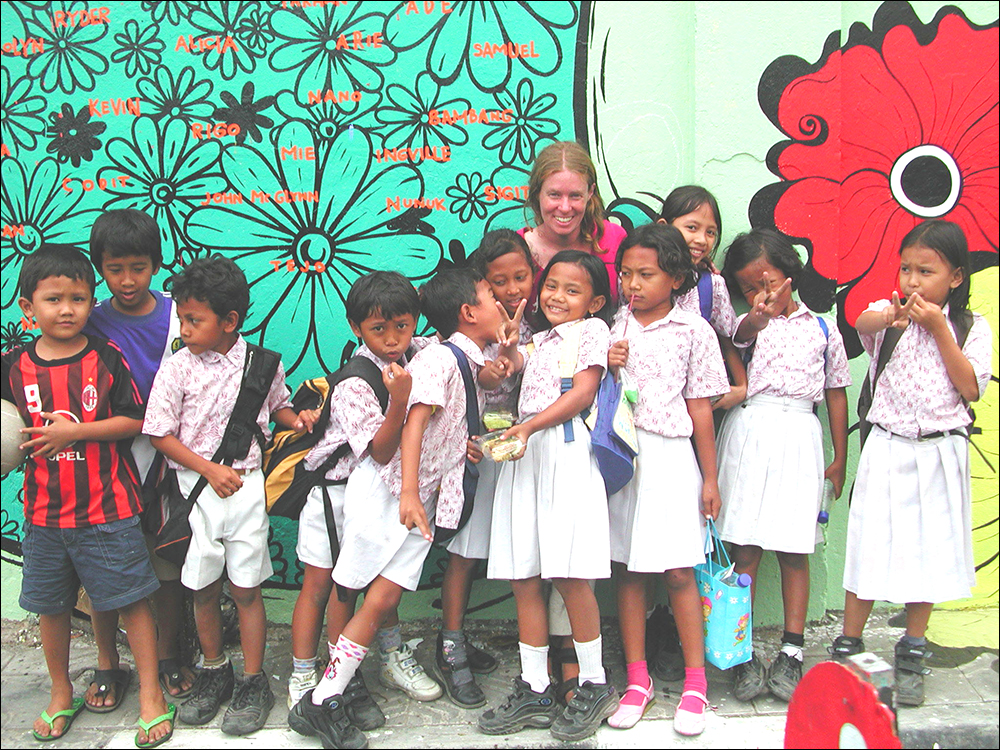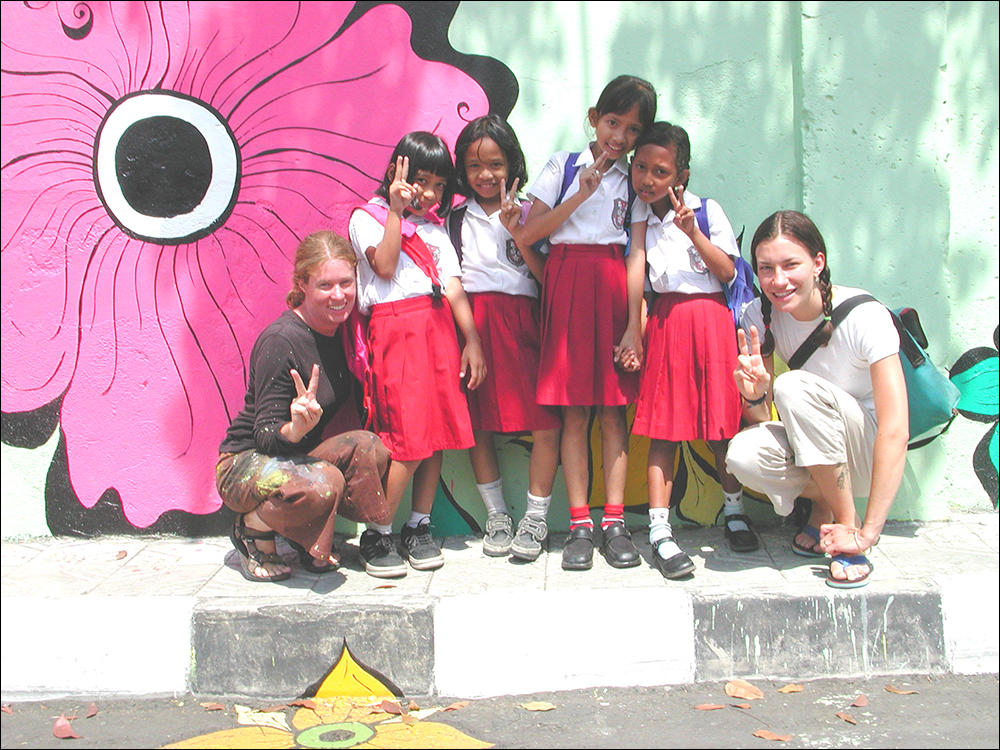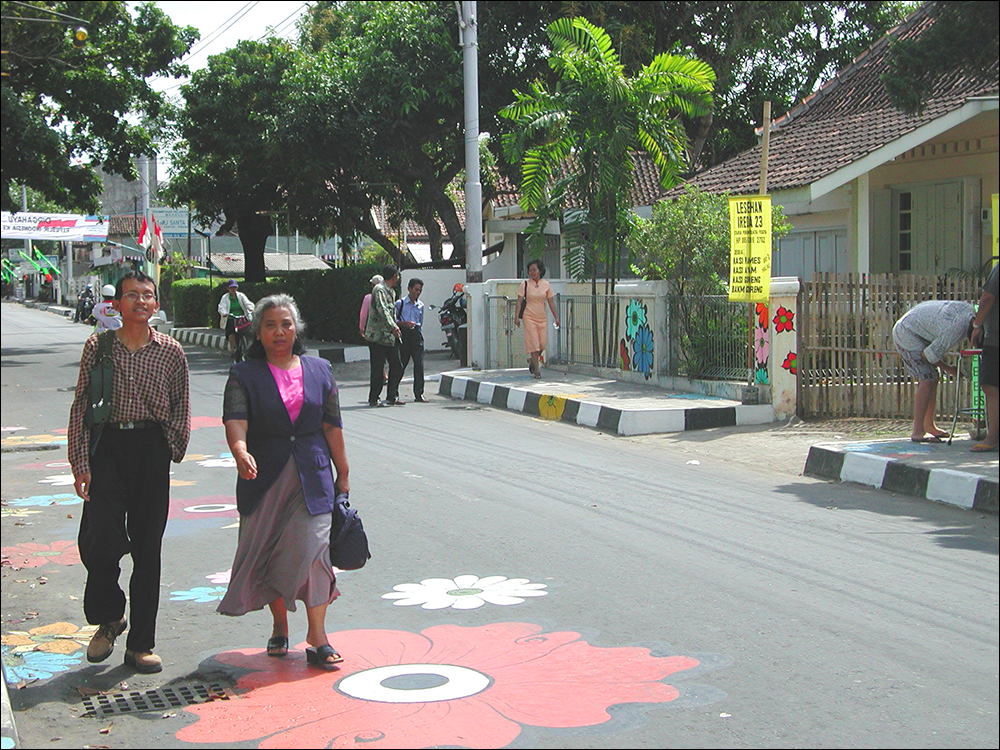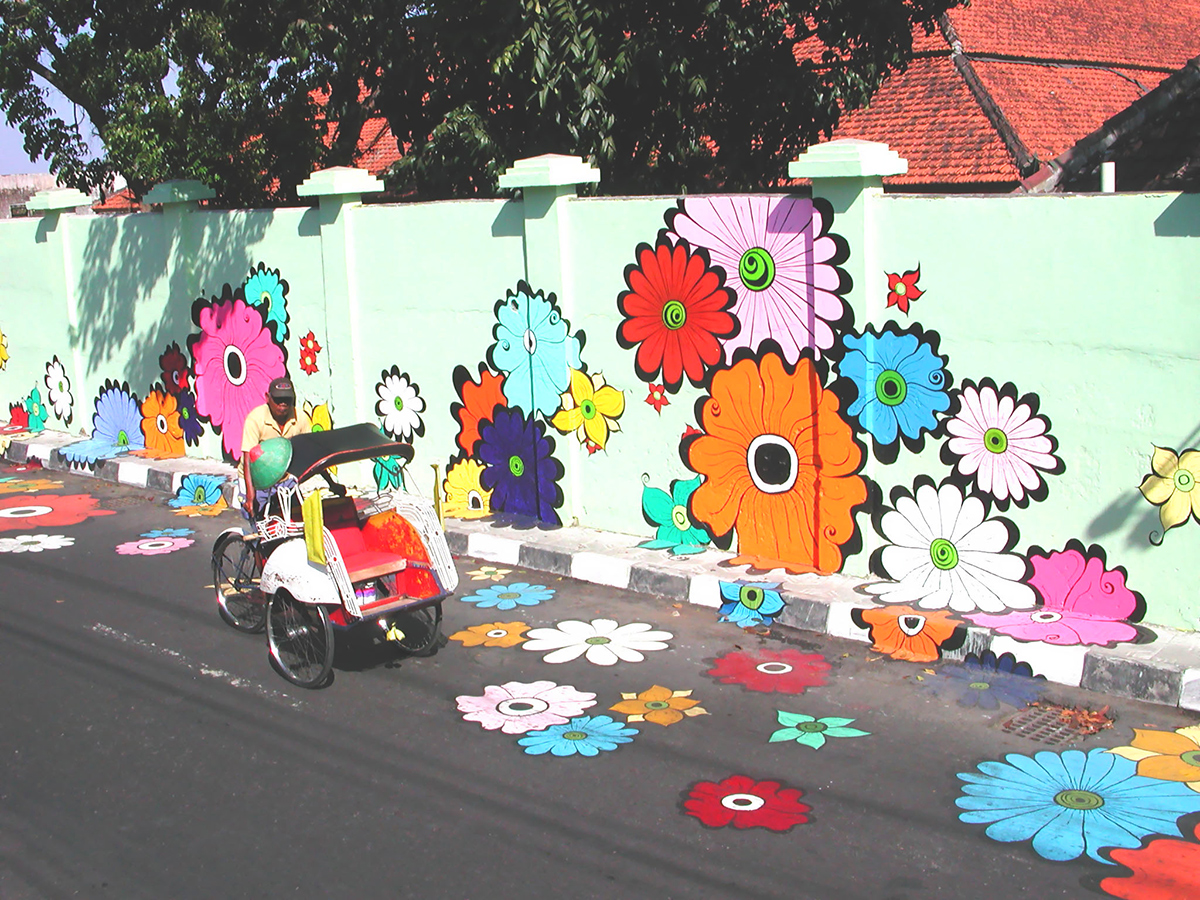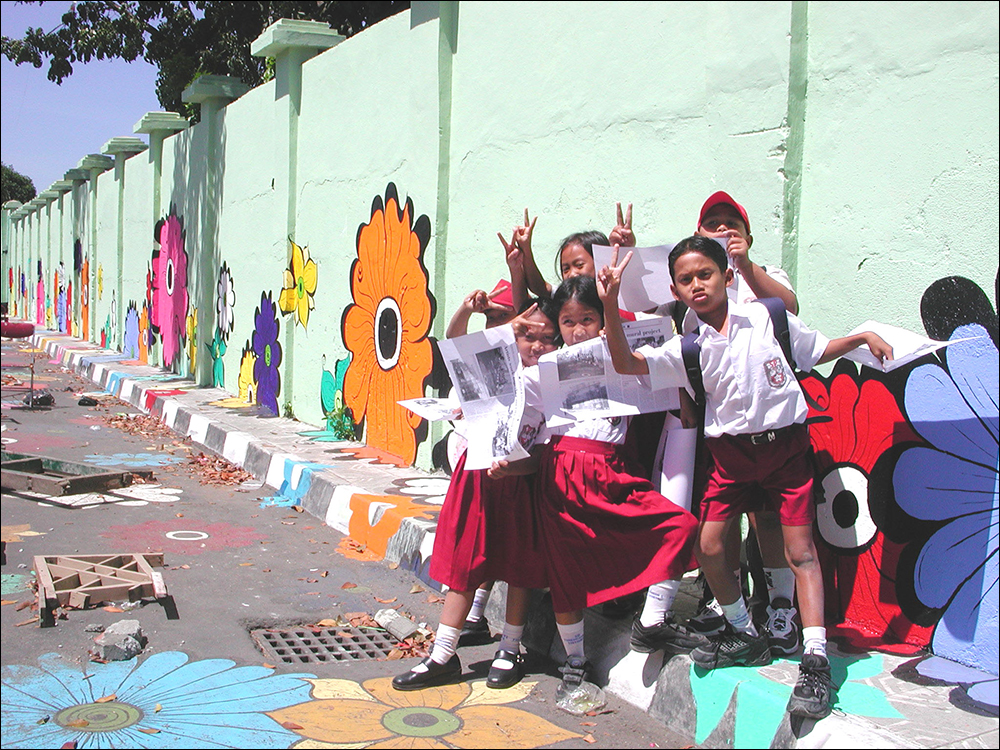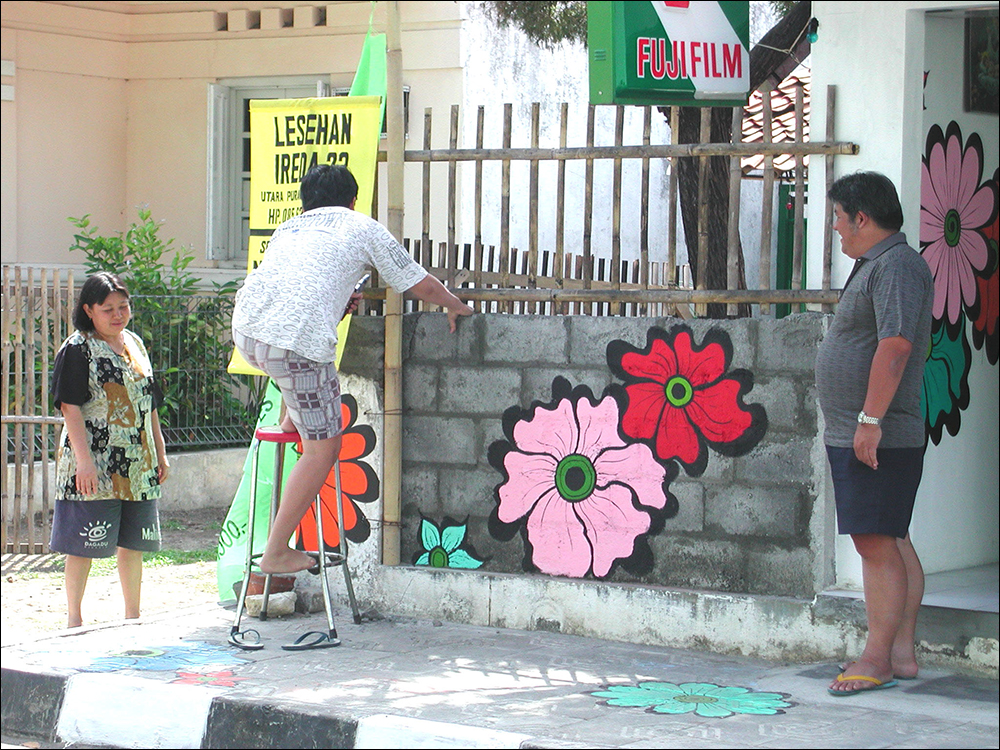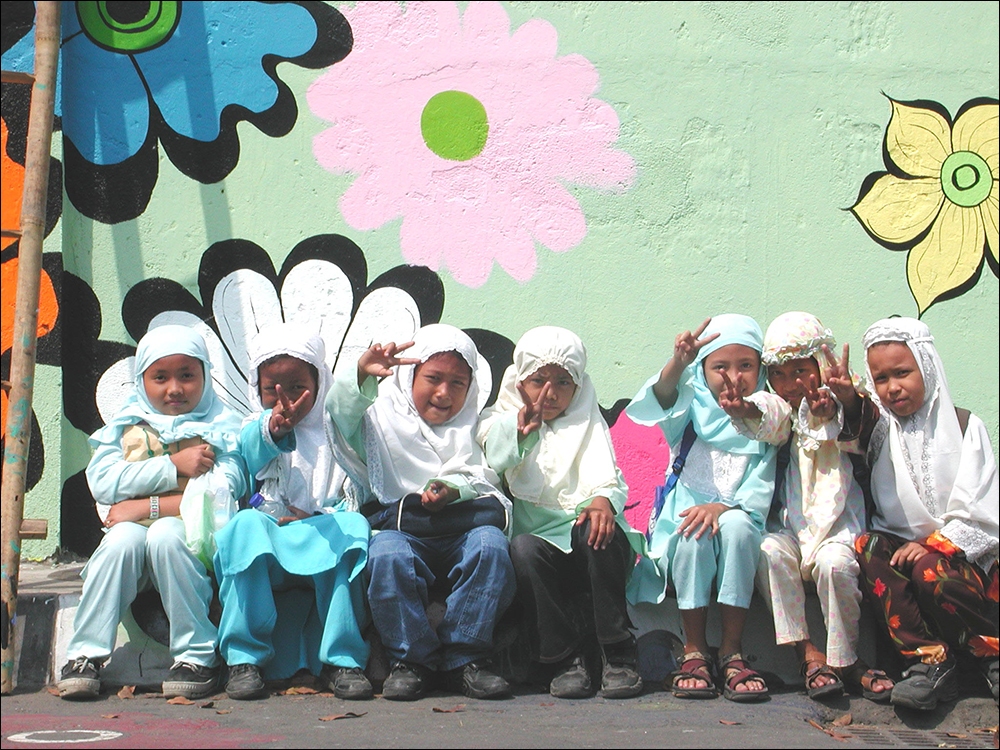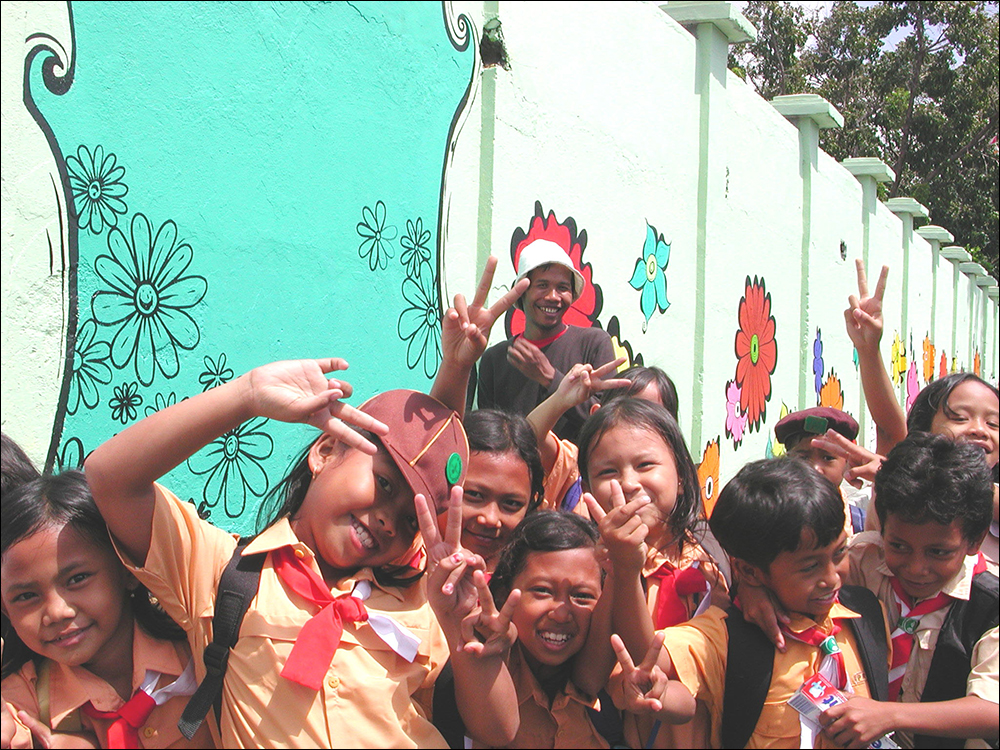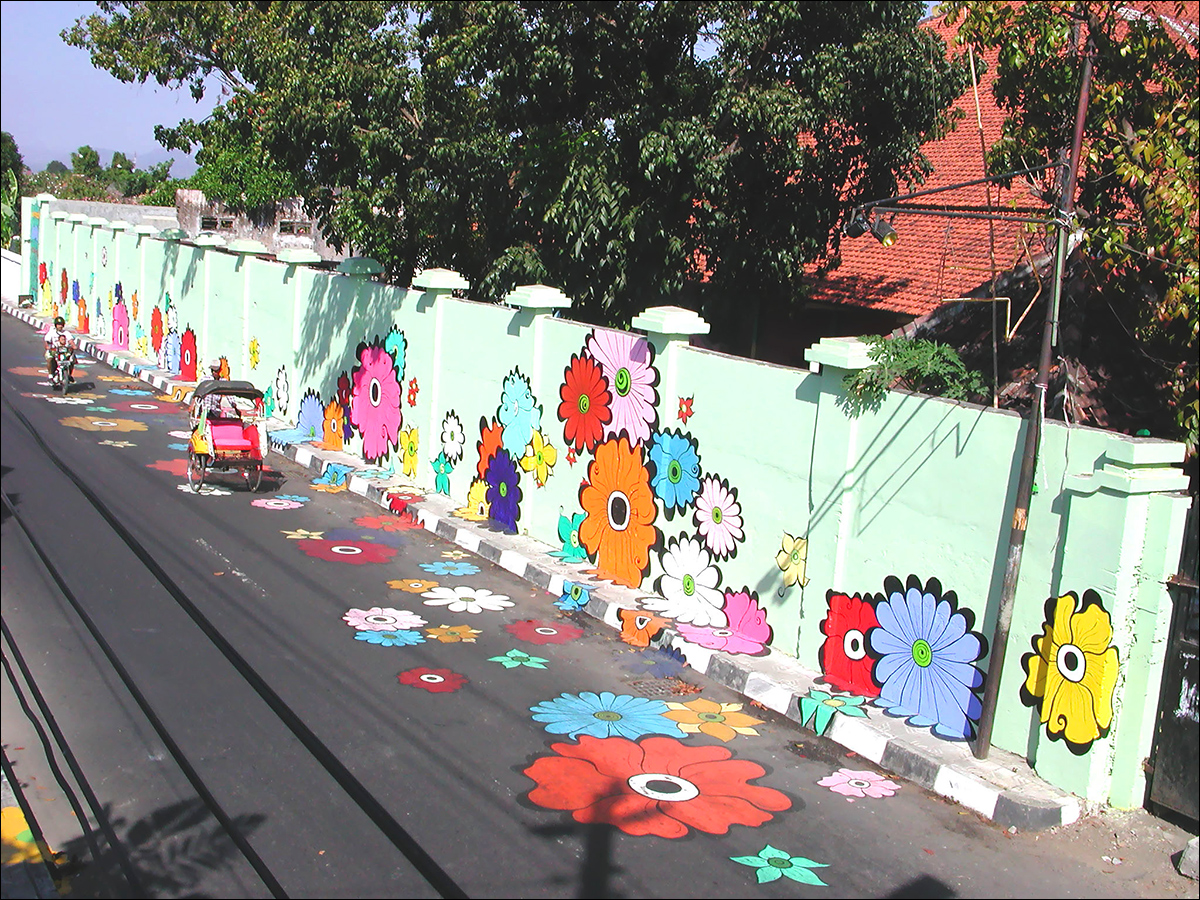Bunga Bunga
Bunga Bunga was part of Sama-sama/Together, an international collaboration and exchange project between community arts organizations and artists from San Francisco, California and Yogyakarta, Indonesia.
Bunga Bunga, mural installation, acrylic on wall and oil enamel on pavement, Jalan Ireda, Yogyakarta, Indonesia, 2003
In July/August 2003 Wilson traveled with five Bay Area artists (Carolyn Castaño, Carolyn Ryder Cooley, Alicia McCarthy, Aaron Noble, Andrew J. Schoultz) to Yogyakarta, Indonesia as the first part of an international exchange project, Sama-Sama/Together, with artists from the Yogyakarta-based collective Apotik Komik (Arie Dyanto, Samuel Indratma, Arya Panjalu, Nano Warsono). The project was designed to foster understanding of contemporary art and culture between the two communities through the creation of new mural works, as well as through cross-cultural dialogue between participating artists and the public at large. Over the course of six weeks, all of the artists created new murals in neighborhoods throughout Yogyakarta.
View from above, looking down Jalan Ireda
The process for the design and creation of the murals was left up to each of the artists. However, Apotik Komik paired all of the San Francisco artists with an Indonesian artist to work with as an assistant or as a collaborator for the duration of the project. Apotik also arranged for the permission of the sites prior to our arrival. After we arrived and viewed the sites collectively we discussed which sites we were each interested in working with.
Farhan with the wall he designed and painted for the Thank You’s
Megan with the women who worked at the tailor shop across the street from the wall
Initially my design was a nod to Mount Merapi, a powerful force and active volcano to the north of Joga. However, after I began, I realized it was too daunting. I then chose the design of the flowers (bunga bunga) for the same reasons that I’ve worked with this imagery in my Flower Interruption project – 1) as a strategy for breaking up the expected; 2) as a rejection of corporate values and the dominance and acceptance of advertising in public space; 3) as a striking contrast to the grit and gray of the city; and 4) as a universal symbol of peace and giving. I was also interested in expanding the traditional notion of the mural as a 2-dimensional image on a vertical wall by including the sidewalk, street, and opposite side of the street.
Jalan Ireda blocked off for painting
I would also meet people who didn’t live in the neighborhood, but would stop by (some daily) to see the progress and to talk with me about the project, as well as about the United States and current events. The consensus seemed to be that people there hated the Bush administration and they were very worried about the impact of hate and fear the US government was, and still is, spreading throughout the world. They were happy to hear that a majority of people in the United States had the same opinion and completely agreed with this perspective, including all of the San Francisco artists. It felt good to be able to provide them with a more realistic viewpoint and alternative to the limited images they’d been fed by mainstream media.
Neighbors
Neighbors
View from inside the house across the street from the wall
Finished mural
Jalan Ireda, street blocked off for painting
In 2003 murals were new to Yogyakarta, a dense city with many low, dilapidated, buildings, overcrowded streets (Indonesia in 2003 was the fifth most populated country in the world), and heavy pollution. Yogya is also the cultural and intellectual center on Java, with a very supportive arts community. The first official mural project was launched by Apotik Komik in August 2002 and included the creation of over 20 new murals by 17 artists. The 2002 project was part one of Sama-Sama in Yogya, in preparation for the collaboration with the San Francisco artists.
Megan painting in the photoshop across the street from the wall
I worked in a neighborhood (Jalan Ireda) that included residences, small family-run businesses, several schools, and a large cultural center, the Purawisata. I painted on a 115 foot long/ 10 foot high wall on the outside of the Purawisata complex. I was paired with an artist named Farshansiki, who had participated in the city-wide mural project in 2002. I was very impressed with Farhan’s work and was excited to have the opportunity to work closely with him. While we didn’t collaborate (Farhan needed to be in Jakarta for a week at the beginning of the project), Farhan did design the “Terima Kasih” (Thank You) wall of my mural and the hope is that we’ll collaborate together in the future.
Farhan painting
Initial mural inspired by Mount Merapi that I decided was too ominous of an image to use.
Megan painting
I spent 4 weeks painting everyday (all 7 days of the week) from about 8:00am until 6:00pm with a 2 hour break for lunch. The heat (85 – 95 degrees) and the sun were intense and I was constantly reminded that I should be wearing a hat, which I rarely did. The community response was quite positive – although neighbors did get frustrated after a couple of weeks with the partial closure of the street. As I painted throughout the day, I would get many people passing by calling out “Bagus!” which means “Beautiful!” and giving me the thumbs up. I also met many of the community members in the neighborhood, which was one of the most rewarding aspects of the project -- I was invited over for lunch and tea; I was invited to paint inside one of the businesses and on the outside of several of the homes across the street from the wall; I was assisted for several days by a young woman high school student named Annin, who lived across the street and whose family would let me keep my paint in their garage; and every day, six days a week, I was visited by a group of elementary school kids who would stop by on their way home from school and want to have their picture taken – it became a daily ritual that I looked forward to.
The photoshop owner and his son
Neighbors
Photoshop



